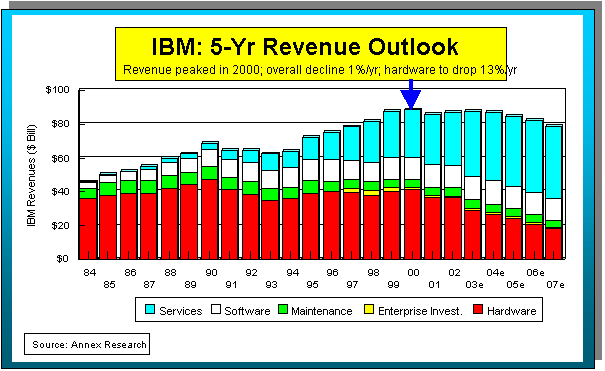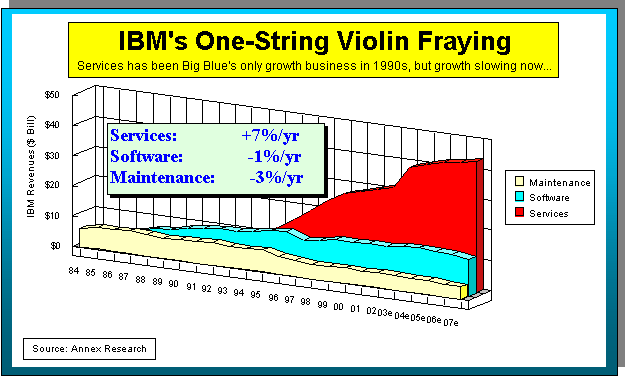

Annex Research| Annex Bulletins|
Index 2003 | Search| Feedback| Clips| Activism| Quotes|
![]()
The copyright-protected information contained in the ANNEX
BULLETINS is a component of the Comprehensive Market Service (CMS). It is
intended for the exclusive use by those who have contracted for the entire
CMS service.
An Open Client Edition
![]()
IBM CORPORATE
Annex Research Five-year Forecast for IBM
Save, Spend and Split
A Three-pronged Strategy Recommendation: Key to IBM’s Growth Beyond 2004 Will Be Savvy Acquisitions
 PHOENIX,
May 8 - Now that Sam
Palmisano is firmly in control of the Big Blue battleship, people have
been asking us what strategy advice we would give him, just as many kept
popping the same question 10 years ago, when Lou Gerstner took over the
IBM helm (see “Gerstner
Spills the Beans…”, Dec 2002).
PHOENIX,
May 8 - Now that Sam
Palmisano is firmly in control of the Big Blue battleship, people have
been asking us what strategy advice we would give him, just as many kept
popping the same question 10 years ago, when Lou Gerstner took over the
IBM helm (see “Gerstner
Spills the Beans…”, Dec 2002).
Well,
our advice to Sam would be pretty simple.
We see a three-pronged triad that could be the basis of continued
IBM turnaround and growth. It
could be summed up as a “triple S-strategy”
- Save, Spend
and Split.
And here’s why…
The
only way Big Blue may get nimbler and substantially bigger beyond 2004 is
through savvy acquisitions, preferably in the services sector.
Which is basically the same advice we offered the IBM CEO over a
year ago (see “From
Here to Eternity…”, Apr 2002).
Here’s an excerpt:
“As to… catching the next wave, the best way to do it is not for
Big Blue to sit around and pray, hoping the inspiration would magically
come out of the blue. Rather,
IBM should go out and seek it proactively - meaning IBM should ‘go
fishing.’ Instead of
wasting money on stock buybacks, IBM should start buying up a whole lot of
promising upstarts, hoping to find a pearl among the oysters.”
For,
IBM’s chances for substantial “organic” growth beyond 2004 are
well… slim to none.
That’s one of the conclusions we reached last year, and again
now, upon completing the 2003 update to our five-year forecast for IBM.
Here’s what we said a year ago:
“Had Gerstner had the foresight to do it (grow by acquisitions), can you imagine how many creative ventures a company could have acquired for $46 billion it has squandered on share repurchases?”, we said in “From Here to Eternity…” (Apr 2002).
But
first things first…. Before being able to spend
billions of dollars on such acquisitions, IBM will first have to Save.
So forget the wasteful stock buybacks, for example, as we also said
over a year ago:
“The
first signal of whether or not Sam Palmisano is up to the job of returning
IBM back to growth will come on just that issue - stock buybacks.
If he allows that nonsense to continue, most sensible shareholders
should head for the hills. And most valuable IBM employees should get their resumes out
on the street, before the hordes of laid off Big Blue Sheeple get
theirs.” (see “From
Here to Eternity…”, Apr 2002).

Well,
Sam appears to have listened. Dropping
stock buybacks was one of the first major decisions IBM’s new CEO has
made to reverse the hemorrhaging of cash on unproductive scams that his
predecessor had instituted (see “Turnaround
Continues...”, Apr
15, and “Start
of a Real Turnaround?”, Jan
17).
Last
but not least, IBM will have to Split up
if it is to grow. Yes, partly
along the line of the IBM break up that we proposed over seven years ago
(see "Break
Up IBM!", Mar 1996). But
also internally, like an amoeba, so as to facilitate renewed growth (see
Annex Bulletin 93-17, Mar 1993). Such
is the price of success. The
bigger you get and the faster you grow, the more often you have to split
up so as to continue growing:
“As
the Austrian sociologist, Leopold Kohr, wrote in his 1957 book, ‘The
Breakdown of Nations,’ (that’s right - 1957, not 1975!), ‘it is
always bigness, and only bigness, which is the problem of existence -
social, as well as physical.’ Kohr concluded that the only solution
must lie in cutting down of the substances and organisms which have
‘outgrown their natural limits’.” (see
“Death
of Corporation,” July 1999).

In
business, determining what such “natural limits” are is both an art
and a test of a CEO’s mettle and humility.
Most industrial era’s CEOs have tended to be empire builders.
They thought that “bigger is better.”
The former IBM CEO was one of them.
Big
Blue needs the other kind.
It needs a CEO who will recognize that bigness can be a handicap,
not just an advantage.
And that nowhere is that truer than in the IT services business.
Over the next five years, we’ll see what kind of a CEO Palmisano
will turn out to be.
It will be his Split
strategy, or a lack thereof, that will tell the tale.
Five-year Forecast
Barring
IBM’s adoption of our three-pronged recommendation, Big Blue as we know
it today will begin to shrink again after 2004.
And it may never again reach or surpass the revenue peak of $88.4
billion it attained in 2000.
We
expect IBM revenues to decline at a compound annual rate of 1% during the
next five years (2003-2007). But,
the revenues will grow by about 8% this year, and before flattening out in
2004. After that, stand by
for their descent to pre-1997 levels ($78 billion) over the following
three years (see the chart on page 2).
As
we’ve already noted in “Shrunk
by the Marketplace” (Apr
17), IBM 2002 revenues
were merely at the same level it was five years earlier (in 1998).
Which means that, unless IBM adopts an aggressive acquisition
strategy, the company will have wasted a decade by basically staying put
or shrinking.
One
reason for an expected lack of growth over the next five years is that IBM
is in too many declining businesses.
The only Big Blue business unit that can be expected to show any
kind of growth is IBM Global Services (IGS).
We
figure that the services (without maintenance) will grow by about 7%
annually between 2003 and 2007. That’s when it will account for about $43.4 billion or 56%
of IBM’s total revenues. With
maintenance, which we figure will decline at about 3% annually, IGS will
represent about 61% of IBM’s total in 2007.
IBM
hardware products, on the other hand, not long ago the mainstay of Big
Blue’s business and its pride and joy, will drop by 13% compounded
annually between 2003 and 2007. Hardware will account for only $16 billion or just over
one-fifth of IBM revenues five years from now.
Software
revenues will also drop, albeit at a slower rate.
They will decline at 1% annually to 16% of IBM 2007 revenues.
As a result, IBM profit margins will erode as will the company’s earnings. Big Blue gross margins have already dropped from 56% to 37% between 1990-2003. Operating margins shrank from 16% to 11% during the same period.

IBM
net margins, on the other hand, had remained relatively stable between
1990-2001 (at about 8% to 9%), despite the many turbulent changes that had
taken place at Armonk during the 1990s decade.
Then they tumbled to 4.1% in 2002, mostly on the heels of the
write-offs associated with sale of hard disk products to Hitachi.
We
expect the IBM net margins to bounce back this year to just over 8%, and
then rise again to 9% in 2004. After
that, however, the negative effect of IBM’s declining hardware
businesses will take its toll on IBM earnings.
As a result, the net margins will slide down to about 5% in 2007.
That’s
barring any unforeseen calamities during that period, of course, which
could make things even worse for Big Blue.
Or better, if Big Blue decides to Save,
Spend and Split.
Happy
Bob Djurdjevic
For additional Annex Research reports, check out...
2003: “Save, Spend and Split” (May 8), “Shrunk by the Marketplace” (Apr 17), “Turnaround Continues...” (Apr 15), “Start of a Real Turnaround?” (Jan 17).
2002 IGS: "Half or Double Trouble?" (Aug. 12, 2002), "IBM to Take $500M Charge" (Sep 3, 2002), IBM-PwCC Update (Oct 2, 2002), Analysis of IBM Second Quarter Results (July 17, 2002), IBM Layoffs Confirmed! (Aug 14, 2002), Analysis of IBM Third Quarter Results (Oct 16, 2002), Boom Amid Gloom and Doom (Oct 10, 2002)
2002 IBM: “Gerstner: The Untold Story” (Dec 27), "Gerstner Spills the Beans" (Dec 13), "On a Wing and a Prayer" (Oct 21), "IBM-PwC Tie the Knot" (Oct 2), "Half or Double Trouble?" (Aug 12), Wall Street/Main Street Chasm (June 25), “Wall Street Casino,” (June 21), Big Blue Salami (June 19), "Looming IBM Layoffs" (May 14), "IBM 5-Yr Forecast: From Here to Eternity?" (Apr 2002), “Tough Times, Soft Deals,” (Apr 25, 2002), “Gerstner’s Legacy: Good Manager, Poor Entrepreneur” (Jan 2002), IBM Pension Plan Vapors: Where Did $17 Billion Go? (Mar 2002), "Sir Lou OutLayed Lay!" (Apr 1, 2002).
A selection from prior years: Is IBM Cheating on Taxes, Annex Bulletin 99-17 (May 1999), IBM 5-year Forecast 2001: An Unenviable Legacy (June 2001), "Break Up IBM!" (Mar. 1996), Fortune on IBM (June 15, 2000), “Smoke and Mirrors Galore,” July 2000), "Slam Dunk of Bunk" (Jan 2000), Annex Bulletin 98-14 ("Wag the Big Blue Dog"), Armonk's Fudge Factory (Apr. 9, 1999), Where Armonk Meets Wall Street, Greed Breeds Incest (November 1998), Stock Buybacks Questioned: Is IBM Mortgaging Its Future Again?, 97-18 (4/29/97), "Some Insiders Cashed In On IBM Stock's Rise, Buybacks" 97-22, 7/27/97, Djurdjevic’s Forbes column, "Is Big Blue Back?," 6/10/97; “Executive Suite: How Sweet!,” (July 1997), "Gerstner: Best Years Are Behind", Aug. 10, 1999), "IBM's Best Years Are 3-4 Decades Behind Us" (July 1999), "Lou's Lair vs. Bill's Loft" (June 1999), "Corporate Cabbage Patch Dolls," 98-39, 10/31/98; Djurdjevic’s Chronicles magazine October 1998 column, "Wall Street Boom; Main Street Doom", “Louis XIX of Armonk,” (Aug. 1996), "Mountain Shook, Mouse Was Born" (Mar. 25, 1994), “A Nice Guy Who Lost His Compass” (Jan 26, 1993), “Akers: The Last Emperor?” June 1991), Industry Stratification Trend (Mar. 30, 1990), etc.]
![]()
